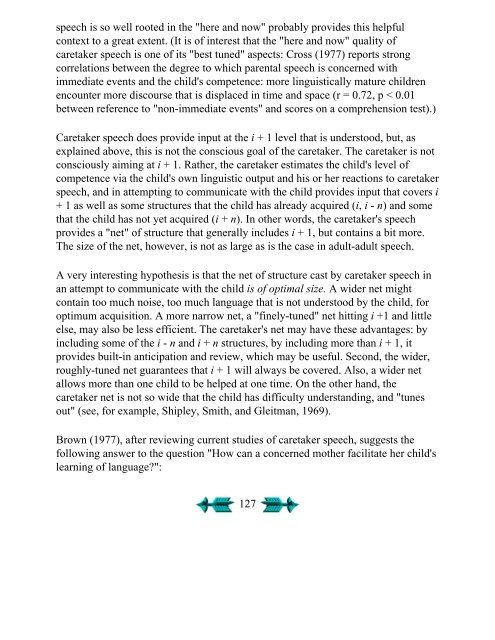Second Language Acquisition and Second ... - Stephen Krashen
Second Language Acquisition and Second ... - Stephen Krashen
Second Language Acquisition and Second ... - Stephen Krashen
You also want an ePaper? Increase the reach of your titles
YUMPU automatically turns print PDFs into web optimized ePapers that Google loves.
speech is so well rooted in the "here <strong>and</strong> now" probably provides this helpful<br />
context to a great extent. (It is of interest that the "here <strong>and</strong> now" quality of<br />
caretaker speech is one of its "best tuned" aspects: Cross (1977) reports strong<br />
correlations between the degree to which parental speech is concerned with<br />
immediate events <strong>and</strong> the child's competence: more linguistically mature children<br />
encounter more discourse that is displaced in time <strong>and</strong> space (r = 0.72, p < 0.01<br />
between reference to "non-immediate events" <strong>and</strong> scores on a comprehension test).)<br />
Caretaker speech does provide input at the i + 1 level that is understood, but, as<br />
explained above, this is not the conscious goal of the caretaker. The caretaker is not<br />
consciously aiming at i + 1. Rather, the caretaker estimates the child's level of<br />
competence via the child's own linguistic output <strong>and</strong> his or her reactions to caretaker<br />
speech, <strong>and</strong> in attempting to communicate with the child provides input that covers i<br />
+ 1 as well as some structures that the child has already acquired (i, i - n) <strong>and</strong> some<br />
that the child has not yet acquired (i + n). In other words, the caretaker's speech<br />
provides a "net" of structure that generally includes i + 1, but contains a bit more.<br />
The size of the net, however, is not as large as is the case in adult-adult speech.<br />
A very interesting hypothesis is that the net of structure cast by caretaker speech in<br />
an attempt to communicate with the child is of optimal size. A wider net might<br />
contain too much noise, too much language that is not understood by the child, for<br />
optimum acquisition. A more narrow net, a "finely-tuned" net hitting i +1 <strong>and</strong> little<br />
else, may also be less efficient. The caretaker's net may have these advantages: by<br />
including some of the i - n <strong>and</strong> i + n structures, by including more than i + 1, it<br />
provides built-in anticipation <strong>and</strong> review, which may be useful. <strong>Second</strong>, the wider,<br />
roughly-tuned net guarantees that i + 1 will always be covered. Also, a wider net<br />
allows more than one child to be helped at one time. On the other h<strong>and</strong>, the<br />
caretaker net is not so wide that the child has difficulty underst<strong>and</strong>ing, <strong>and</strong> "tunes<br />
out" (see, for example, Shipley, Smith, <strong>and</strong> Gleitman, 1969).<br />
Brown (1977), after reviewing current studies of caretaker speech, suggests the<br />
following answer to the question "How can a concerned mother facilitate her child's<br />
learning of language?":<br />
127











